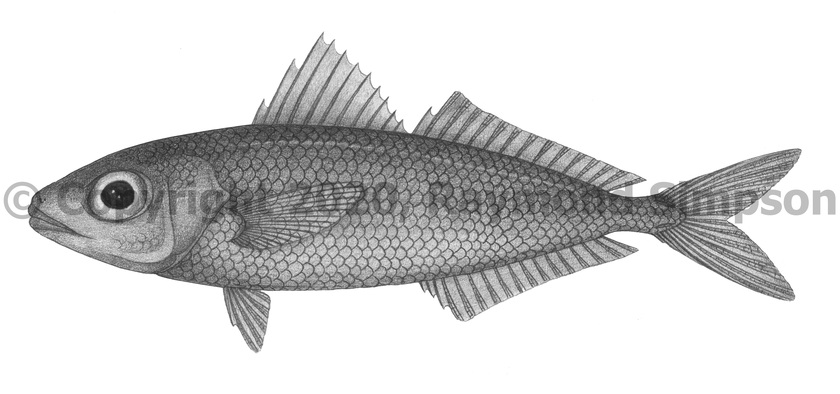
Common Name
Brown Driftfish
Year Described
Ginsburg, 1954
Identification
Dorsal Fin: XI, I, 14-17
Anal Fin: III, 13-16
Pelvic Fin: I, 5
Pectoral Fin: 21-23
Gill Rakers: 26-30
Vertebrae: 30-31
Lateral Line Scales: 50-65
Body fusiform and cylindrical in cross-section. Head large with slightly oblique, terminal mouth. Snout short. Eye large. Upper jaw short and covered by pre-orbital bone. Very small teeth along jaw but not on palatine or vomer. Edge of opercle smooth. Caudal peduncle short and cylindrical with two fleshy keels on each side of caudal fin base. Dorsal fins barely separated. Second dorsal and anal fin of similar length. Caudal fin forked. Pectoral fins reach base of dorsal fin. Pelvic fins under base of pectoral fins. Dorsal and pelvic fins retract into groove. Lateral line high on body and ending before caudal peduncle. Head sensory pores very well developed and much more extensive than in A. bondi. Scales cycloid; covering body forward to top of head. Three scale rows between dorsal and lateral line. Head scales extend forward to the anterior margin of orbit.
Color
Uniformly brown to blue-black, without a strong bicolored appearance. Fins also darker. Peritoneum dark.
Size
Maximum size to 25cm SL.
Habitat
Lives in relatively deeper waters from 200-600m. Juveniles live near the surface.
Range
Continental slopes from New York to S. Florida and the Gulf of Mexico. Also off Central America and Brazil.
References
Carpenter, K.E. 2002. The living marine resources of the Western Central Atlantic (Vol. 3, pp. 1375-2127). Rome, Italy: Food and agriculture organization of the United Nations.
Horn, M.H. 1972. Systematic status and aspects of the ecology of the elongate ariommid fishes (Suborder Stromateoidei) in the Atlantic. Bulletin of Marine Science, 22(3), 537-558.
Other Notes
This species and Ariomma bondi are closely related but can be distinguished by lateral scale counts, the forward extent of the scales on the head, the development of the sensory system on the head, peritoneum color, and depth of capture (Horn, 1972).